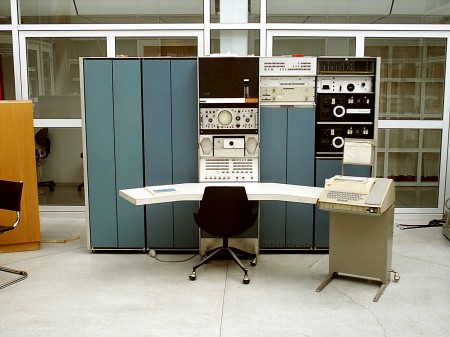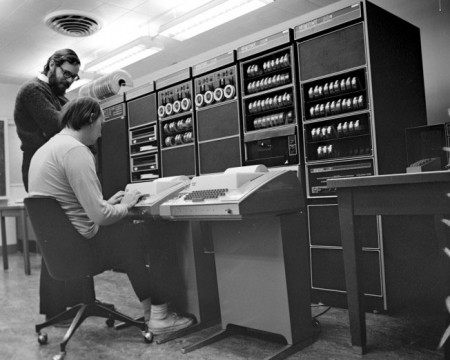Columbia’s DEC PDP-7
Posted by Scott

The DEC PDP systems never cease to be a source of inspiration for me and the above example of a PDP-7 system at Columbia’s Electrical Engineering department is no exception. I am not sure who took this photo as there was no credit included (source: Columbia Computing History). It would be tempting to gut the cases and fill them with modern studio equipment if you could find a nice used example. Also, if you have an oscilloscope in your computer you win.
For you Mac heads out there, this is your great-grand daddy. A PDP-7, referred to as the “Unix Genesis Machine”, was used by Ken Thompson and his team in 1969 to develop the Unix OS (a very early precursor to what would become Mac OS X).


16 Comments Leave A Comment
Liam says:
January 14, 2009 at 4:49 amWho would known that keyboards were standing in the way of progress all that time > http://twelvemagazine.tumblr.com/post/70053125/steve-jobs-people-who-use-keyboards-standing-in
Josh Korwin says:
January 14, 2009 at 5:50 amAlong those lines, check out this panorama I shot of the equipment used to monitor solar activity at the Mt. Wilson Observatory. It’s been in use since the ’70s—if they were to upgrade it, they would jeopardize the consistency of their long-term data collection.
http://www.picturebubbles.com/gallery/2007-11-15-mt-wilson-solar-telescope-office.html
jacklyn says:
January 14, 2009 at 6:44 amoh wow. my dad { computer engineer } used to tell me about the old days when one computer system took up a whole room. thanks for showing me the proof. these are amazing.
Jason says:
January 14, 2009 at 10:05 amHey Josh, how’d you shoot that panorama? It’s a nice view into the Mt. Wilson Observatory.
Daniel Carvalho says:
January 14, 2009 at 2:43 pmThose old machines are neat, reminds me of several prop models that were created for the game Team Fortress 2.
Josh, probably the best panorama I’ve seen, very cool. I like that chair by the clock :) Now that’s retro.
douglas says:
January 14, 2009 at 10:28 pmTotally unrelated but man, some people just aren’t a shame to rip off:
http://www.flickr.com/photos/30545042@N07/3072691877/
Josh Korwin says:
January 15, 2009 at 12:30 amThanks for the props guys (and sorry for the shameless self-promotion on your blog, Scott)! Long story short, we (PictureBubbles°) shoot the panoramas with fisheye lenses in high dynamic range. Much less time is spent shooting than in post-production! There are some other great shots scattered throughout the examples page and the blog, but I wanted to share that one shot here because of the nutty old computer equipment. Reminded me of HAL 9000 with *all* the Kubrick removed. :)
Mike Hatch says:
January 15, 2009 at 2:17 amHi, that PDP-7 at Columbia’s Electrical Engineering, is actually machine #115 that was shipped to Oslo University in 1966 and is now owned by Tore Sinding Bekkedal, his site for the machine is here – http://toresbe.at.ifi.uio.no/dec/pdp7/agi/ – compare the photos. I have a site dedicated to the PDP-7 here – http://www.soemtron.org/pdp7.html – including a customer list of the known 99 machines from the 120 systems that were built. Your photo was taken by either Tore or Alberto Gonzalez Iniesta who took the photos on tore’s website. I’m afraid the photo Columbia have used is of Tore’s machine as it is probably the only good photo of a PDP-7 existing on the web. Columbia’s machine is not in the 99 on the list so is probably one of the 21 unknown machines.
Mike says:
January 15, 2009 at 9:14 amColumbia Computing History have now updated their information for the PDP-7 photo reflecting the origin of the photo used on this blog, along with with further info links.
Mike says:
January 16, 2009 at 5:40 amThe above photo of Columbia’s Electrical Engineering department’s PDP-7 is of a PDP-7A serial #115 delivered in 1966 to Oslo University, now owned by Tore Sinding Bekkedal, http://toresbe.at.ifi.uio.no/dec/pdp7/agi/, the photo appears on Wikimedia commons with the comment “The Oslo PDP-7, before restoration started. I took the picture.”
Mike says:
January 16, 2009 at 6:00 amThe second photo is of a PDP-11 from around 1971/2 or so. PDP-7’s were used by Thompson and his team on either or all of PDP7 machines #3, #34, #44 or or PDP-7A #149.
Thompson and Ritchie bought a PDP-11 in 1971 for $65,000, using it to finalise UNIX using C, after using Fortran and BCPL or B (which evolved into C) as their code, see – http://www.linfo.org/pdp-7.html
Mike says:
January 20, 2009 at 5:35 amFound it!, the second photo is from here – http://cm.bell-labs.com/cm/cs/who/dmr/picture.html – it’s Ken Thompson (seated) and Dennis Ritchie at a PDP-11/20 in 1972, a Bell Labs publicity photo.
Reattkaheduct says:
January 30, 2009 at 2:09 amblog.iso50.com – cooooolest domain name)))
ReewDwelaykem says:
February 15, 2009 at 1:16 pmYour web page does not correctly work in safari browser
LIKHIT says:
December 20, 2010 at 10:18 pmThe blog and the links in blog are really worthy!! thanks guys